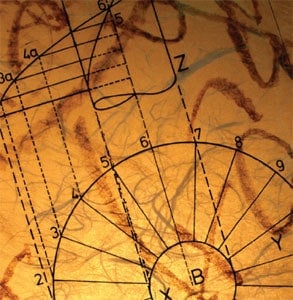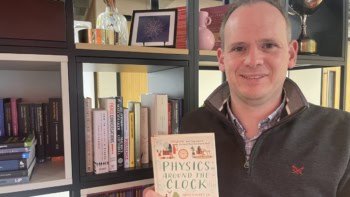Galileo's famous metaphor of the "book of nature", which he used to defend the work of scientists from religious authorities, can be dangerous today, says Robert P Crease

In 1623 Galileo crafted a famous metaphor that is still often cited by scientists. Nature, he wrote, is a book written in “the language of mathematics”. If we cannot understand that language, we will be doomed to wander about as if “in a dark labyrinth”.
Like other metaphors, this one has two facets; it is insightful, but it may be misleading if taken literally. It captures our sense that nature’s truths are somehow imposed on us – that they are already imprinted in the world – and underlines the key role played by mathematics in expressing those truths.
But Galileo devised the metaphor for a specific purpose. Taken out of its historical context and placed in ours, the image can be dangerously deceptive.
The two books
The idea of a book of nature did not, however, originate with Galileo. For centuries it had been an accepted part of religious doctrine that the world contained two fundamental books. Nature, the first book, is full of signs that reveal a deeper meaning when interpreted according to scripture, the second book, which supplies the ultimate meaning or syntax of nature’s signs. Understanding involved reading the books together, going back and forth between what one finds in the world and what one reads in scripture. Indeed, reading the Bible was once considered part and parcel of studying nature, and not in any way anti-scientific.
During the Renaissance, however, scholars came to appreciate more keenly that the truths of nature were not always easy to discern. Rather, such truths were often cleverly encoded in nature and so required a special training to unlock. Meanwhile, the Protestant Reformation brought about changes in the understanding of texts, emphasizing the truths in them that were exact and self-contained rather than symbolic or allegorical.
Building on these scientific and religious changes, in 1623 Galileo decided to appropriate the “two books” metaphor for his own purposes to get him out of a jam. In fact, his troubles had begun a decade earlier, when one of his students was discussing Galileo’s work at the Pisan court, and a participant noted the apparent conflict between scripture and Galileo’s scientific claims, especially regarding the motion of the Earth. The authorities were also threatening to put De Revolutionibus, written by Galileo’s intellectual ally Copernicus, on the official index of forbidden books for similar reasons.
Worried for himself and for other scientists, Galileo wrote a letter to the Grand Duchess Christina about the connection between science and scripture. In that letter he appealed to the traditional image that God reveals himself to humanity in two books – nature and scripture. He suggested that both books express eternal truths and are compatible because they have the same author – God is saying the same thing in two different ways.
Galileo’s arguments seem to have convinced Christina, but not the authorities. In 1616 De Revolutionibus was put on the index, followed by Kepler’s textbook on Copernican astronomy in 1619, and Galileo himself came under attack. Partly in response he wrote The Assayer, which contains the famous passage that “the grand book of the universe…cannot be understood unless one first learns to comprehend the language and to read the alphabet in which it is composed…the language of mathematics”. Those versed in mathematics and physics, in other words, can know aspects of God’s handiwork that others cannot.
Galileo chose his metaphor carefully, and its roots were deep in Western metaphysics and theology. First, it used the traditional idea that God revealed his power, glory and truth in the world. Second, it relied on the equally traditional notion that the Bible cannot go against clear demonstrations of logic or the senses. Finally, it appealed to the time-honoured analogy of nature as a book. Galileo was on solid theological ground.
In fact, Galileo had stood the old image on its head, even if he was not fully aware of what he had done. The image of the book of nature now implied something almost opposite to what it had before – that the signs of nature had their own self-contained meaning. To understand nature one did not need to rely on the Bible as an allegorical aid; studying nature was an independent activity best carried out by a separate, professional class of scholars. If anything, the book of nature now became the primary text – the blueprint, written in technical language – and scripture the user’s manual, written in popular language.
Galileo was suggesting that scientists were as authoritative as the clergy. As Peter Harrison remarks in his book The Bible, Protestantism, and the Rise of Natural Science, “the book of nature and those natural philosophers who interpreted it…assumed part of the role previously played by the sacraments and the ordained priesthood”.
The critical point
But the image of the book of nature can haunt us today. One reason is that it implies the existence of an ultimate coherent truth – a complete text or “final theory”. While many scientists may believe this, it is ultimately only a belief, and it is far likelier that we will endlessly find more in nature as our concepts and technology continue to evolve. Furthermore, the image suggests that the “text” of the book of nature has a divine origin. The idea that the world was the oeuvre of a superhuman author was the precursor of the idea that it was the engineering project of an intelligent designer. This implication has led some contemporary sociologists of science to succumb to the temptation of characterizing scientists as behaving, and seeking to behave, in a priest-like manner.
The most important lesson to be found in Galileo’s image is the need to keep developing and revising the metaphors with which we speak about science.



